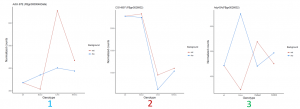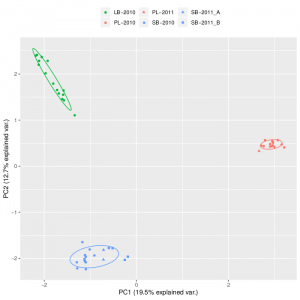Switch language:
-
Pistlar og atburðir
- Contributions to ICEBIO25
- (Icelandic) Fjórðungi bregður til nafns: af uppnefndum genum og sérvisku erfðafræðinga
- Nicinthya Pajanissamy was a great and wonderful human and student
- Variation of tooth traits in ecologically specialized and sympatric morphs vs 2.
- Whole genome sequencing reveals how plasticity and genetic differentiation underlie sympatric morphs of Arctic charr.
Plastic charr at Oikos 2020
Sarah E. Steele presented her work in the Oikos meeting last week.
Mechanisms and axes of developmental plasticity and evolutionary divergence. Sarah Steele, Dagný Runarsdottir, Bjarni Kristjansson, Skuli Skulason, Prof Camille Leblanc, Sigridur R. Franzdottir, Zophonias Jonsson, Sigurdur Snorrason, Arnar Palsson.
Why are some species plastic and capable of rapid phenotypic diversification and polymorphism, while others are less flexible at the phenotype level and evolve more slowly? This question has puzzled geneticist and students of evolution for over a century, but new technologies have made it addressable. Here we set out to investigate the developmental and genetic basis of plasticity and polymorphism, applying experimental and molecular methods on the extremely diverse salmonid, Arctic charr (Salvelinus alpinus). Arctic charr has, in about 10,000 years following the ice age glacier retreat, invaded and adapted to diverse habitats, and in the process small benthic forms evolved in dozens of locations. Arctic charr is phenotypically very heterogeneous, to the extent that morphotypes were originally classified as distinct species, but also show high levels of phenotypic plasticity. We use a combination of genetic crosses, geometric morphometrics and next generation sequencing to characterize the plastic response to benthic or limnetic food. We compared wild stocks and their hybrids, reared in the laboratory, after hatching and while the juveniles are taking food. The results illuminate how we understand of the relationship of ecologically induced developmental plasticity and evolution of ecological specializations.
Marion Dellinger also presented data on behavioral phenotypes of the fishes from this experiment.
Tell me how you eat, I'll tell you who you are: how does feeding modalities affect personality distribution in the Arctic charr (Salvelinus alpinus)?
Posted in Articles about science
The Icelandic biology conference 2019
Late last year the lab took part in the Icelandic biology conference. The conference is biannual, and the largest aggregation of biological researchers in Iceland.
Our lab contributed several works to the meeting, and Im very proud of the students for their contributions.
Here is a list of the projects that they presented:
Can you save a mutant? Expressional rescue of 3 major wing defects in Drosophila melanogaster Baldur Kristjánsson, Dagný Á. Rúnarsdóttir, Sudarshan Chari, Ian Dworkin, Arnar Pálsson
Waddingtons landscapes explored: Expression changes associated with genetic assimilation of crossveinless phenotypes Dagný Ásta Rúnarsdóttir, Baldur Kristjánsson, Sarah Marzec, Ian Dworkin, Arnar Pálsson
Study of the genetic and developmental basis of phenotypic differences between sympatric Arctic charr (Salvelinus alpinus) morphs Nahal Eskafi, Alexander Guðjónsson, Sylvain Moinard, Lea J. Plesec, Sigurður S. Snorrason, Zophonias O. Jonsson, Arnar Palsson, Sigríður Rut Franzdóttir
Differential expression of transcription factors between Arctic charr morphsLea Jerman Plesec, Alexander Guðjónsson, Sébastien Matlosz, Jóhannes Guðbrandsson, Arnar Pálsson, Sigríður Rut Franzdóttir, Zophonías O. Jónsson
Posted in Talks and events
Videos from conference of Bioethics of clinical innovation and unproven methods, Copenhagen, 9 April 2019
Bioethics of clinical innovation and unproven methods, Copenhagen, 9 April 2019
Conference organized by the Nordic Committee on Bioethics in collaboration with Centre for Legal Studies in Welfare and Market at the University of Copenhagen. The central questions were:
How are clinical innovations and unproven methods developed and introduced in western Nordic health-care systems?
What is the legal and regulatory environment concerning unproven methods in medicine?
What ethical principles should guide work on emerging treatments and experimentation in hospitals?
These are questions that were addressed in the NCBio-conference in Copenhagen.
Videos of talks from the meeting on bioethics of clinical innovation and unproven methods Copenhagen, 9 April 2019 are available.
I had the great privilege of organizing this event with my colleagues in the Nordic Committee on Bioethics, in collaboration with the Centre for Legal Studies in Welfare and Market at the University of Copenhagen.
The conference is open to all interested, including medical doctors, clinical researchers, health committees in parliments, civil servants and hospital administrators.
Posted in General biology
(Icelandic) Geta vísindin sagt mér hversu mikill neanderdalsmaður ég er?
Posted in Vísindavefur - svör
(Icelandic) Ný grein um bleikjuafbrigðin í Þingvallavatni
Icelandic press about the paper on differentiation between the sympatric morphs in Lake Thingvallavatn.
Posted in Articles about science, General biology
Extensive genetic differentiation between recently evolved sympatric Arctic charr morphs
The availability of diverse ecological niches can promote adaptation of trophic specializations and related traits, as has been repeatedly observed in evolutionary radiations of freshwater fish. The role of genetics, environment and history in ecologically driven divergence and adaptation, can be studied on adaptive radiations or populations showing ecological polymorphism. Salmonids, especially the Salvelinus genus, are renowned for both phenotypic diversity and polymorphism. Arctic charr (Salvelinus alpinus) invaded Icelandic streams during the glacial retreat (about 10,000 years ago) and exhibits many instances of sympatric polymorphism. Particularly well studied are the four morphs in Lake Þingvallavatn in Iceland. The small benthic (SB), large benthic (LB), planktivorous (PL) and piscivorous (PI) charr differ in many regards, including size, form and life history traits. To investigate relatedness and genomic differentiation between morphs we identified variable sites from RNA-sequencing data from three of those morphs, and verified 22 variants in population samples. The data reveal genetic differences between the morphs, with the two benthic morphs being more similar and the PL-charr more genetically different. The markers with high differentiation map to all linkage groups, suggesting ancient and pervasive genetic separation of these three morphs. Furthermore, GO analyses suggest differences in collagen metabolism, odontogenesis and sensory systems between PL-charr and the benthic morphs. Genotyping in population samples from all four morphs confirms the genetic separation and indicates that the PI-charr are less genetically distinct than the other three morphs. The genetic separation of the other three morphs indicates certain degree of reproductive isolation. The extent of gene flow between the morphs and the nature of reproductive barriers between them remain to be elucidated.
Figure 2.
Posted in Publications
Talks and posters at Evolution and core processes in gene expression
Baldur and I attended a meeting on evolution of gene expression arranged by David Arnosti, Shinhan Shiu and colleagues.
Evolution and Core Processes in Gene Expression
May 9–12, 2019 East Lansing, Mich.
Baldur and I ended up pooling our talks into one, as he only got a flash talk and presented a poster.
Thus we presented the data from the transcriptome analyses of Ian Dworkin and Sudarshan Charis wing defect compensation experiment.
BioRxiv preprint: Compensatory evolution via cryptic genetic variation: Distinct trajectories to phenotypic and fitness recovery.
The titles of the abstracts Baldur and I submitted were Transcriptome changes after compensatory selection suppressed the phenotypic effects of two antagonizing developmental genes and Overcoming deleterious mutations at transcript level: Full length transcript expression in vg1 mutant flies restored by compensatory selection.
We are still working on the manuscripts.
The figure below is an example from the analyses of net and rhomboid compensatory evolution.
Posted in Publications, Talks and events
Genatjáning í snemmþroskun og erfðabreytileiki bleikjuafbrigðanna í Þingvallavatni
Það er með töluverðu stolti sem ég fleyti hér áfram tilkynningu um doktorsvarnar erindi Jóhannesar. Það verður kátt í Öskjunni föstudaginn 26 apríl, 2019.
Erindið verður kl. 14:00 í stofu 132.
Doktorsefni: Jóhannes Guðbrandsson
Heiti ritgerðar: Genatjáning í snemmþroskun og erfðabreytileiki bleikjuafbrigðanna í Þingvallavatni
http://luvs.hi.is/vidburdir/genatjaning_i_snemmthroskun_og_erfdabreytileiki_bleikjuafbrigdanna_i_thingvallavatni
Ágrip
Fjögur afbrigði bleikju (Salvelinus alpinus) finnast í Þingvallavatni. Afbrigðin eru talin hafa þróast innan vatnsins frá lokum síðustu ísaldar og eru ólík hvað varðar m.a. stærð, útlit, lífsferla og fæðuöflun. Meginmarkmið verkefnisins var að auka skilning á hvaða sameinda- og þroskunarferlar liggja að baki mismunandi svipgerð afbrigðanna og meta erfðafræðilega aðgreiningu þeirra á milli. Könnuð var genatjáning í snemmþroskun í leit að mismunandi tjáðum genum sem gætu þannig bent á hvaða ferlar móta þroskun ólíkra svipgerða. Erfðabreytileiki meðal afbrigðanna var metinn og athugað hvort að erfðaset með mikinn mun í tíðni samsæta, meðal afbrigða, fyndust í genum með svipuð líffræðileg hlutverk og/eða væru bundin við ákveðna staði innan erfðamengisins. Tvenns konar aðferðarfræði var beitt, í fyrsta lagi að kanna áhugaverð gen með sértækum aðferðum og í öðru lagi að rannsaka allt umritunarmengið (með RNA-raðgreiningu). Niðurstöðurnar afhjúpa ólíka genatjáningu og erfðamun milli afbrigðanna. Munur í tjáningu finnst á genum í mörgum líffræðilegum ferlum sem bendir til töluverðar aðgreiningar afbrigðanna og að mögulega hafi mörg gen verið undir náttúrulegu vali. RNA-niðurbrot í sýnum, líklega vegna tæknilegra vandkvæða í meðhöndlun þeirra, hækkaði flækjustig greininga á RNA-raðgreiningargögnum. Greining umritunarmengisins var engu að síður gagnleg þar sem tjáningarmunur fannst í genum sem tengjast myndun utanfrumugrindar og beinmyndun. Gögnin sýna mikinn mun í tíðni samsæta meðal afbrigða og var mikinn mun að finna víða í erfðamenginu. Það getur bent til æxlunarlegrar einangrunar afbrigðanna og/eða náttúrulegs vals á mörgum litningasvæðum. Mikill erfðamunur fannst til dæmis í genum tengdum ónæmiskerfinu með sértækum aðferðum og aðgreinandi erfðabreytileiki í genum tengdum kollagen-efnaskiptum og umhverfisskynjum (sjón, heyrn) var áberandi í umritunarmenginu. Genatjáningarmunur í fóstrum og skýr munur í erfðasamsetningu afbrigðanna bendir til að þau séu komin áleiðis inn á “veg tegundamyndunar”.
Jóhannes fæddist árið 1985 og ólst upp á Staðarhrauni á Mýrum. Hann lauk BS prófi í líffræði frá Háskóla Íslands árið 2008 og BS prófi í stærðfræði frá sama skóla árið 2010. Jóhannes hóf doktorsnám í lífræði haustið 2009. Frá árinu 2012 hefur hann verið hlutastarfi hjá Veiðimálastofnun, sem varð að Hafrannsóknastofnun árið 2016, þar sem hann stundar rannsóknir á laxfiskum. Hann sinnti einnig aðstoðarkennslu í ýmsum líffræðigreinum í Háskólanum meðfram námi.
Andmælendur:
Dr. Kathryn Elmer, dósent við stofnun líffræðilegs fjölbreytileika, dýraheilsu og samanburðar-læknisfræði við háskólann í Glasgow.
Dr. Jón H. Hallson, dósent við auðlinda- og umhverfisdeild Landbúnaðarháskóla Íslands.
Leiðbeinandi: Dr. Arnar Pálsson, prófessor við Líf- og umhverfisvísindadeild Háskóla Íslands.
Einnig í doktorsnefnd:
Dr. Zophonías O. Jónsson, prófessor við Líf- og umhverfisvísindadeild Háskóla Íslands.
Dr. Sigurður S. Snorrason, prófessor við Líf- og umhverfisvísindadeild Háskóla Íslands.
Dr. Einar Árnason, prófessor við Líf- og umhverfisvísindadeild Háskóla Íslands.
Dr. Páll Melsted, prófessor við Iðnaðarverkfræði-, vélaverkfræði- og tölvunarfræðideild Háskóla Íslands.
Doktorsvörn stýrir: Dr. Snæbjörn Pálsson, prófessor og varadeildarforseti Líf- og umhverfisvísindadeildar Háskóla Íslands.
Sjá viðburð á facebook
Posted in Graduate students

